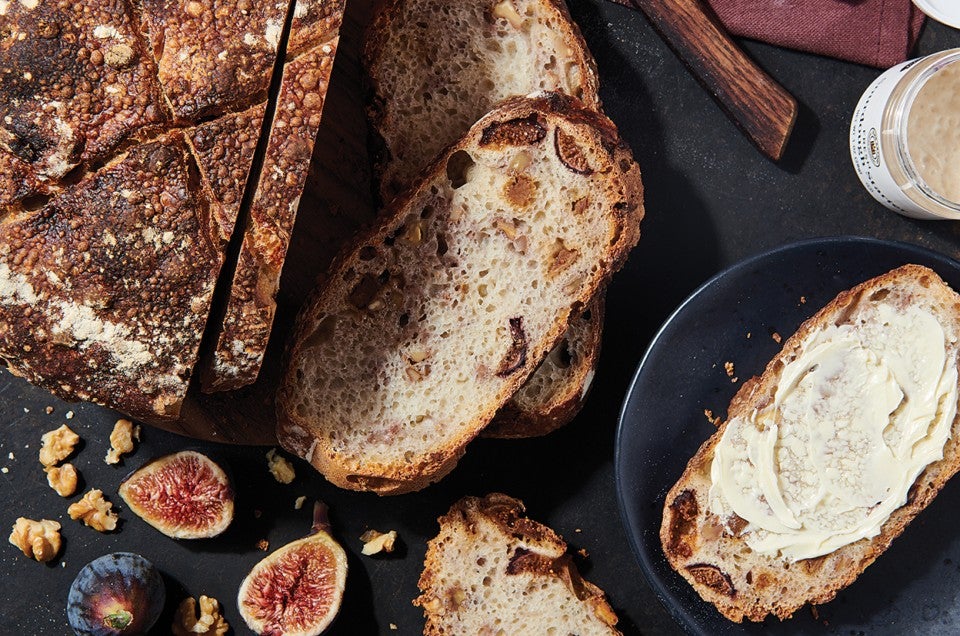Fig and Walnut Sourdough
This robust, crusty sourdough is studded with rich figs and crunchy walnuts. It's a terrific partner for any artisanal cheese. If you don't have figs, dried cranberries are a tasty and colorful substitute.

This robust, crusty sourdough is studded with rich figs and crunchy walnuts. It's a terrific partner for any artisanal cheese. If you don't have figs, dried cranberries are a tasty and colorful substitute.


Weigh your flour; or measure it by gently spooning it into a cup, then sweeping off any excess. In the bowl of your mixer, combine the starter, water, and flour. Mix until smooth. Cover the bowl and let the mixture rest for 1 hour at room temperature; this is known as autolyse.
After an hour, add the salt and yeast, and knead the dough with your mixer's dough hook on medium speed for 5 to 7 minutes. Just before the kneading is done, mix in the figs or cranberries.
Stop the mixer and fold the nuts into the dough using a dough scraper. Cover the bowl again and let the dough rise at room temperature for 40 to 60 minutes.
Turn the dough out onto a lightly greased surface (it will be fairly wet and possibly a bit sticky).
Scoop up the edge of the dough with your dough scraper and bring it to the center, pressing down. Give the dough a quarter turn and repeat three or four more times, turning the dough between each fold. You're strengthening the dough and pre-shaping (rounding) it at the same time.
For two smaller loaves, divide the dough in half and round each.
Flour the banneton(s) you want to use, or a tea towel placed inside a bowl with a shape you find pleasing. Place the rounded dough into the banneton or bowl, bottom side up, cover with plastic wrap, and refrigerate overnight.
The next morning, preheat the oven to 450°F with a baking stone in the lower third. Put 1" of water into a small skillet that can go into the oven. Take your breads out of the refrigerator. They may not have risen a lot; that's OK.
Bring the water in the skillet to a simmer and place it in the bottom of the oven. Place a piece of parchment on a baker's peel or the back of a baking sheet.
Turn the loaves out of their bannetons onto the parchment. Slash the top(s) of the loaves, and slide the bread(s), paper and all, onto the stone in the oven. Spray the inside of the oven generously with water from a spray bottle and set a timer for 5 minutes.
Spray once more when the timer goes off, and bake for another 35 minutes, until the center of the loaf reads 200°F when measured with a digital thermometer.
Remove from the oven and cool on a rack before slicing.
Store leftover bread, well wrapped, at room temperature for several days; freeze for longer storage.
To bake this bread in a Bread and Potato Pot or Dutch oven: Prepare the dough as directed through stretching and folding (step 5). After pre-shaping, put a circle of parchment in the bottom of your chosen baking crock and grease the inside. Place the rounded dough, seam side down in the pot. Cover and refrigerate overnight.
The next day when you’re ready to bake, take the pot out of the refrigerator and let it come to room temperature for 90 minutes. Preheat the oven to 450°F for another 30 minutes. Uncover and slash the top of the bread; replace the cover.
Bake the bread, covered, for 45 to 50 minutes. Then remove the cover and bake for another 10 minutes, until the top is a deep, rich brown. Remove from the oven and turn out of the pot onto a rack to cool completely before slicing.
Don’t have any starter? Here’s a recipe for homemade sourdough starter. If you're making it from scratch, you'll need to feed it for 5 to 7 days before it’s ready for baking. Want a head start? Purchase our classic fresh sourdough starter — it’ll be ready for baking soon after it arrives at your door. Looking for tips, techniques, and all kinds of great information about sourdough baking? Find what you need in our sourdough baking guide.

View our privacy policy

